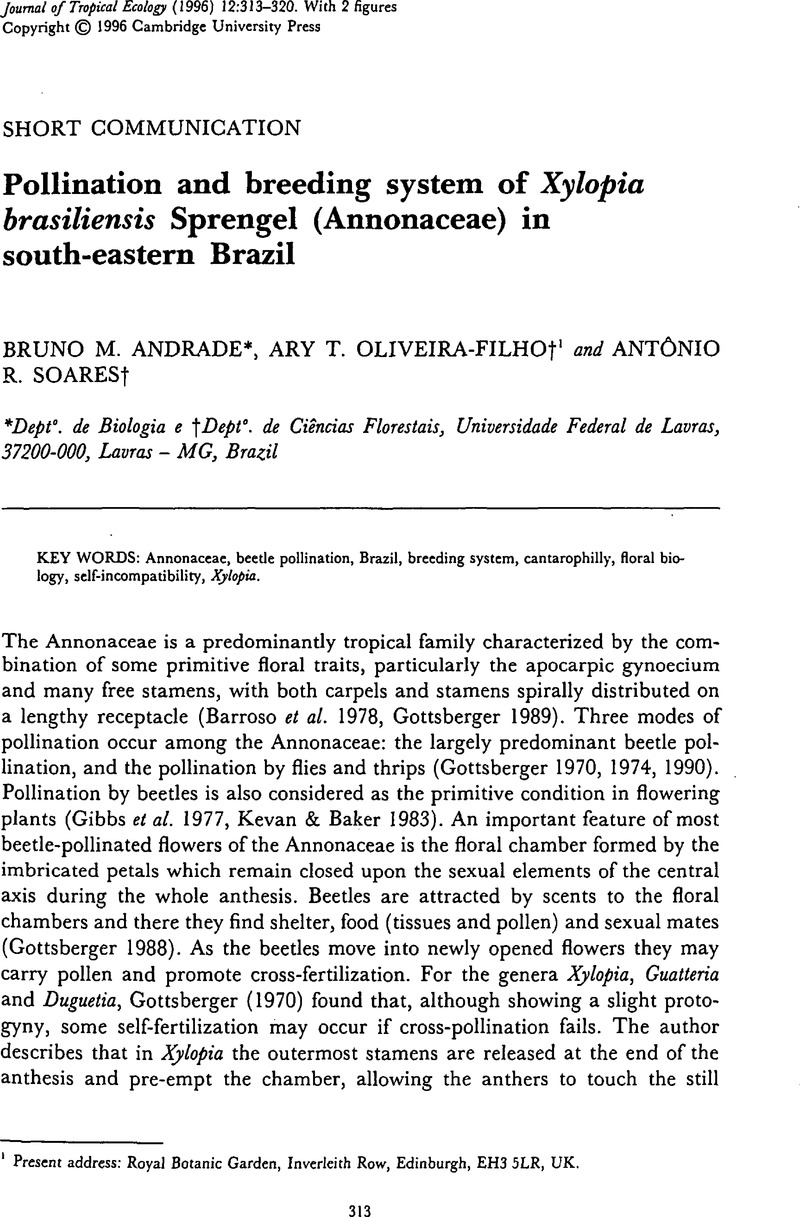Crossref Citations
This article has been cited by the following publications. This list is generated based on data provided by Crossref.
Gottsberger, Gerhard
1999.
Pollination and evolution in neotropical Annonaceae.
Plant Species Biology,
Vol. 14,
Issue. 2,
p.
143.
Endress, Peter K.
and
Lorence, David H.
2004.
Heterodichogamy of a Novel Type in Hernandia (Hernandiaceae) and Its Structural Basis.
International Journal of Plant Sciences,
Vol. 165,
Issue. 5,
p.
753.
Ratnayake, R. M. C. S.
Gunatilleke, I. A. U. N.
Wijesundara, D. S. A.
and
Saunders, R. M. K.
2007.
Pollination Ecology and Breeding System of Xylopia championii (Annonaceae): Curculionid Beetle Pollination, Promoted by Floral Scents and Elevated Floral Temperatures.
International Journal of Plant Sciences,
Vol. 168,
Issue. 9,
p.
1255.
Cavalcante, Tadeu Robson Melo
Naves, Ronaldo Veloso
Franceschinelli, Edivani Villaron
and
Silva, Ricardo Pereira da
2009.
Polinização e formação de frutos em araticum.
Bragantia,
Vol. 68,
Issue. 1,
p.
13.
Teichert, Holger
Dötterl, Stefan
and
Gottsberger, Gerhard
2011.
Heterodichogamy and nitidulid beetle pollination in Anaxagorea prinoides, an early divergent Annonaceae.
Plant Systematics and Evolution,
Vol. 291,
Issue. 1-2,
p.
25.
SAUNDERS, RICHARD M. K.
2012.
The diversity and evolution of pollination systems in Annonaceae.
Botanical Journal of the Linnean Society,
Vol. 169,
Issue. 1,
p.
222.
GOODRICH, KATHERINE R.
2012.
Floral scent in Annonaceae.
Botanical Journal of the Linnean Society,
Vol. 169,
Issue. 1,
p.
262.
Pang, Chun-Chiu
and
Saunders, Richard M. K.
2014.
The evolution of alternative mechanisms that promote outcrossing in Annonaceae, a self-compatible family of early-divergent angiosperms.
Botanical Journal of the Linnean Society,
Vol. 174,
Issue. 1,
p.
93.
Kirmse, Susan
and
Ratcliffe, Brett C.
2019.
Composition and Host-Use Patterns of a Scarab Beetle (Coleoptera: Scarabaeidae) Community Inhabiting the Canopy of a Lowland Tropical Rainforest in Southern Venezuela.
The Coleopterists Bulletin,
Vol. 73,
Issue. 1,
p.
149.
Kirmse, Susan
and
Chaboo, Caroline S
2020.
Flowers are essential to maintain high beetle diversity (Coleoptera) in a Neotropical rainforest canopy.
Journal of Natural History,
Vol. 54,
Issue. 25-26,
p.
1661.
Paiva, Elder Antônio Sousa
Galastri, Natália Arias
and
Oliveira, Denise Maria Trombert
2021.
Nectary and elaiophore work together in flowers of Xylopia aromatica (Annonaceae): structure indicates a role in pollination.
Botany,
Vol. 99,
Issue. 1,
p.
33.
Pinheiro Saravy, Fábio
Schuchmann, Karl-L.
and
Marques, Marinez I.
2021.
Diversity of Insect Flower Visitors of Xylopia aromatica (Magnoliales, Annonaceae) in a Brazilian Savanna.
Diversity,
Vol. 13,
Issue. 12,
p.
661.
Saravy, Fábio Pinheiro
Marques, Marinez Isaac
and
Schuchmann, Karl-L.
2022.
Life history patterns of coleopteran pollinators of Annona crassiflora Mart. in the Brazilian Cerrado.
Journal of Natural History,
Vol. 56,
Issue. 9-12,
p.
743.



